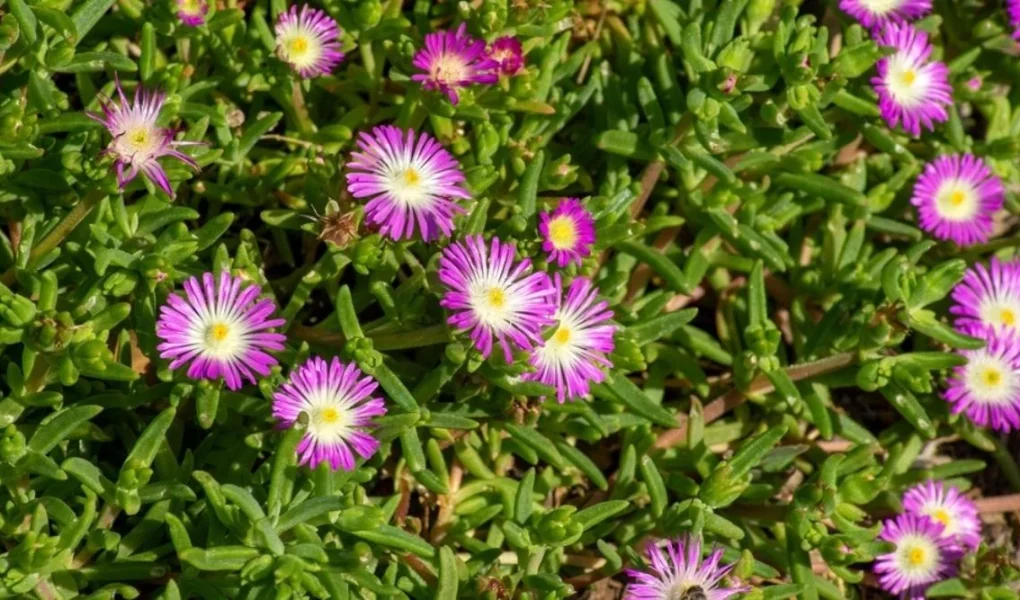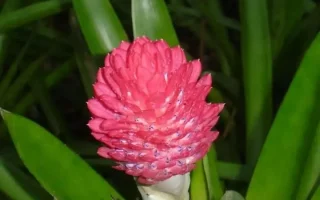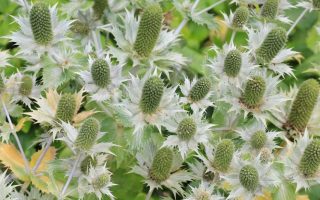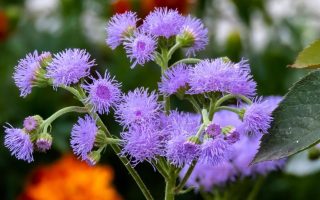kickstand-project.org – Ice plants, known for their bright, vibrant flowers and low-maintenance nature, are an excellent choice for gardeners seeking drought-tolerant plants that add both beauty and texture to their landscapes. These hardy, succulent plants are perfect for creating colorful ground covers, rock gardens, or border plantings, and they thrive in arid conditions, making them ideal for dry climates. In this article, we will explore the characteristics, growing conditions, varieties, and care of the Ice Plant flower, and why it’s a great addition to any garden.
Characteristics of the Ice Plant Flower
The Ice Plant (Delosperma), a member of the Aizoaceae family, is known for its striking, daisy-like flowers that bloom profusely in a wide range of colors, including pink, purple, red, white, and yellow. The plant’s flowers open in the full sun and close up at night, adding a dynamic element to the garden.
The Ice Plant gets its name from the way its fleshy, glistening leaves sparkle in the sunlight, resembling ice crystals. These succulent leaves are thick and fleshy, helping the plant conserve water, making it highly drought-tolerant. In addition to its vibrant flowers, Ice Plants have a low-growing, spreading habit, making them excellent ground covers or fillers for rocky or sandy soils.
Ice Plants are typically evergreen, providing year-round interest in the garden. They are also known for their ability to thrive in poor soils, which makes them ideal for xeriscaping or water-wise gardening.
Ideal Growing Conditions
Ice Plants are incredibly adaptable and can thrive in various climates, particularly in regions with hot, dry summers. Here are the key growing conditions to help your Ice Plant flourish:
- Sunlight: Ice Plants love full sun and need at least 6 hours of direct sunlight each day to bloom profusely. The more sunlight they receive, the more vibrant their flowers will be. They are not suited for shady locations, as this can lead to sparse flowering and poor growth.
- Soil: While Ice Plants can tolerate a range of soil types, they prefer well-drained, sandy, or rocky soil. They do not do well in heavy, clay soils that retain moisture. Amending the soil with sand or gravel can improve drainage, helping prevent root rot.
- Watering: Being succulent plants, Ice Plants are highly drought-tolerant once established. Water them deeply but infrequently, allowing the soil to dry out completely between waterings. Overwatering can lead to root rot, so it’s important to avoid soggy conditions. Ice Plants are particularly well-suited to dry climates and require minimal watering once they are established.
- Temperature: Ice Plants thrive in USDA hardiness zones 5 through 9. They are well-suited to warm, arid climates but can tolerate cooler temperatures, especially if they are well-drained. They can withstand some frost but may need protection during extreme cold temperatures.
- Fertilizing: Ice Plants generally do not require heavy fertilizing. Too much fertilizer can lead to excessive growth and fewer flowers. A light application of a balanced, slow-release fertilizer in the spring can help promote healthy growth and blooms.
Varieties of Ice Plant Flowers
There are several species and cultivars of Ice Plant, each with different flower colors, growth habits, and hardiness. Here are a few popular varieties:
- Delosperma cooperi (Purple Ice Plant): One of the most well-known and widely grown varieties, Delosperma cooperi features bright purple-pink flowers that bloom from spring to summer. This variety is known for its spreading habit and is an excellent ground cover for hot, dry areas.
- Delosperma nubigenum (Yellow Ice Plant): This variety produces cheerful yellow flowers and has a more compact growth habit compared to Delosperma cooperi. It’s perfect for hanging baskets, containers, or as a low-growing ground cover.
- Delosperma ‘Fire Spinner’: This cultivar features vibrant orange and yellow flowers that resemble flames, adding a fiery burst of color to the garden. It’s a popular choice for adding contrast to other drought-tolerant plants.
- Delosperma ‘Razzleberry’: Known for its striking purple-pink blooms, Razzleberry is a compact, hardy variety that forms dense mats of flowers. This variety is ideal for smaller gardens, rock gardens, or as a container plant.
- Delosperma ‘Jewel of the Desert’ Series: This series of Ice Plants features a range of colors, from deep purple to hot pink, and is prized for its compact size and prolific blooms. It’s perfect for edging or as a ground cover in sunny, dry locations.
Benefits of Growing Ice Plant Flowers
Ice Plants offer a variety of benefits, making them a great addition to gardens, particularly those in dry or drought-prone areas:
- Drought Tolerance: Ice Plants are incredibly drought-tolerant once established, making them ideal for xeriscaping or water-wise gardens. Their succulent leaves store water, allowing the plant to withstand dry conditions without the need for frequent watering.
- Attracts Pollinators: The vibrant flowers of Ice Plants attract bees, butterflies, and other pollinators to your garden. These plants are an excellent choice for creating a pollinator-friendly garden that supports local ecosystems.
- Low Maintenance: Ice Plants are easy to care for and require minimal attention. They are relatively pest-resistant and are not prone to diseases, making them a low-maintenance option for gardeners.
- Erosion Control: Due to their spreading nature and ability to thrive in poor soils, Ice Plants are often used for erosion control. They are particularly effective at stabilizing slopes, hillsides, or sandy areas where other plants might struggle to establish themselves.
- Year-Round Interest: Many varieties of Ice Plant are evergreen, providing year-round color and texture in the garden. Even when not in bloom, their fleshy, succulent leaves offer visual interest and structure to the landscape.
Creative Garden Uses
Ice Plants can be used in a variety of ways to add beauty and functionality to your garden. Here are some creative ideas for incorporating Ice Plants into your landscape:
- Ground Cover: Ice Plants make excellent ground covers, particularly for dry, sunny areas. Their spreading habit allows them to cover large areas quickly, reducing the need for grass and other high-maintenance plants.
- Rock Gardens: The succulent nature of Ice Plants makes them ideal for rock gardens. Their ability to thrive in well-drained, sandy soil allows them to flourish in the cracks and crevices of rocks, adding a splash of color to otherwise barren spaces.
- Container Plants: Ice Plants thrive in containers, making them a perfect choice for patios, balconies, and other small spaces. Their vibrant flowers and trailing growth habit make them a stunning addition to hanging baskets, window boxes, or mixed plantings.
- Erosion Control: If you have slopes or areas with poor soil, Ice Plants can help prevent erosion by stabilizing the soil and providing ground cover. Their ability to thrive in challenging conditions makes them an ideal choice for these difficult spots.
- Pollinator Gardens: With their nectar-rich flowers, Ice Plants are a great addition to a pollinator garden. Combine them with other drought-tolerant plants, such as lavender, sage, and coneflowers, to create a vibrant, pollinator-friendly garden.
Conclusion
The Ice Plant flower is a hardy, drought-tolerant plant that offers vibrant color and texture to gardens in dry climates. With its beautiful, daisy-like blooms, succulent leaves, and low-maintenance care requirements, it’s a perfect choice for xeriscaping, ground covers, and rock gardens. Whether you’re looking to attract pollinators, create a water-wise garden, or add color to an arid landscape, Ice Plants are an excellent option that will provide years of beauty with minimal effort. Their unique ability to sparkle in the sun and bloom profusely throughout the summer makes them a delightful addition to any garden.




